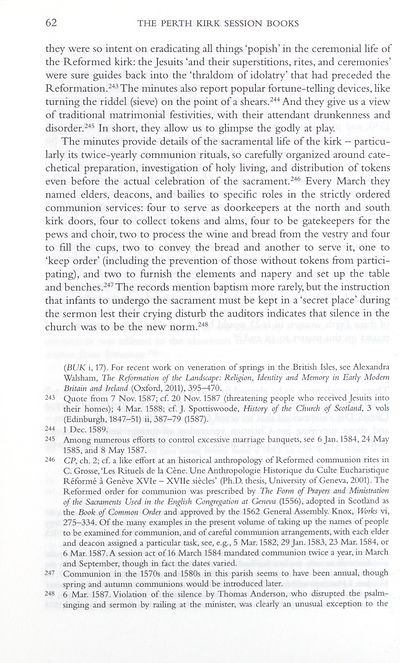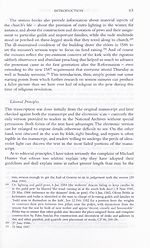Series 6 > Perth Kirk Session books, 1577-1590
(77) Page 62
Download files
Complete book:
Individual page:
Thumbnail gallery: Grid view | List view

62
THE PERTH KIRK SESSION BOOKS
they were so intent on eradicating all things ‘popish’ in the ceremonial life of
the Reformed kirk: the Jesuits ‘and their superstitions, rites, and ceremonies’
were sure guides back into the ‘thraldom of idolatry’ that had preceded the
Reformation.243 The minutes also report popular fortune-telling devices, like
turning the riddel (sieve) on the point of a shears.244 And they give us a view
of traditional matrimonial festivities, with their attendant drunkenness and
disorder.245 In short, they allow us to glimpse the godly at play.
The minutes provide details of the sacramental life of the kirk - particu¬
larly its twice-yearly communion rituals, so carefully organized around cate¬
chetical preparation, investigation of holy living, and distribution of tokens
even before the actual celebration of the sacrament.246 Every March they
named elders, deacons, and bailies to specific roles in the stricdy ordered
communion services: four to serve as doorkeepers at the north and south
kirk doors, four to collect tokens and alms, four to be gatekeepers for the
pews and choir, two to process the wine and bread from the vestry and four
to fill the cups, two to convey the bread and another to serve it, one to
‘keep order’ (including the prevention of those without tokens from partici¬
pating), and two to furnish the elements and napery and set up the table
and benches.247 The records mention baptism more rarely, but the instruction
that infants to undergo the sacrament must be kept in a ‘secret place’ during
the sermon lest their crying disturb the auditors indicates that silence in the
church was to be the new norm.248
(BUK i, 17). For recent work on veneration of springs in the British Isles, see Alexandra
Walsham, The Reformation of the Landscape: Religion, Identity and Memory in Early Modem
Britain and Ireland (Oxford, 2011), 395-470.
243 Quote from 7 Nov. 1587; cf. 20 Nov. 1587 (threatening people who received Jesuits into
their homes); 4 Mar. 1588; cf. J. Spottiswoode, History of the Church of Scotland, 3 vols
(Edinburgh, 1847-51) ii, 387-79 (1587).
244 1 Dec. 1589.
245 Among numerous efforts to control excessive marriage banquets, see 6 Jan. 1584, 24 May
1585, and 8 May 1587.
246 CP, ch. 2; cf. a hke effort at an historical anthropology of Reformed communion rites in
C. Grosse, ‘Les Rituels de la Cene. Une Anthropologic Historique du Culte Eucharistique
Reforme a Geneve XVIe - XVIIe siecles’ (Ph.D. thesis, University of Geneva, 2001). The
Reformed order for communion was prescribed by The Form of Prayers and Ministration
of the Sacraments Used in the English Congregation at Geneva (1556), adopted in Scodand as
the Book of Common Order and approved by the 1562 General Assembly. Knox, Works vi,
275-334. Of the many examples in the present volume of taking up the names of people
to be examined for communion, and of careful communion arrangements, with each elder
and deacon assigned a particular task, see, e.g., 5 Mar. 1582, 29 Jan. 1583,23 Mar. 1584, or
6 Mar. 1587. A session act of 16 March 1584 mandated communion twice a year, in March
and September, though in fact the dates varied.
247 Communion in the 1570s and 1580s in this parish seems to have been annual, though
spring and autumn communions would be introduced later.
248 6 Mar. 1587. Violation of the silence by Thomas Anderson, who disrupted the psalm¬
singing and sermon by railing at the minister, was clearly an unusual exception to the
THE PERTH KIRK SESSION BOOKS
they were so intent on eradicating all things ‘popish’ in the ceremonial life of
the Reformed kirk: the Jesuits ‘and their superstitions, rites, and ceremonies’
were sure guides back into the ‘thraldom of idolatry’ that had preceded the
Reformation.243 The minutes also report popular fortune-telling devices, like
turning the riddel (sieve) on the point of a shears.244 And they give us a view
of traditional matrimonial festivities, with their attendant drunkenness and
disorder.245 In short, they allow us to glimpse the godly at play.
The minutes provide details of the sacramental life of the kirk - particu¬
larly its twice-yearly communion rituals, so carefully organized around cate¬
chetical preparation, investigation of holy living, and distribution of tokens
even before the actual celebration of the sacrament.246 Every March they
named elders, deacons, and bailies to specific roles in the stricdy ordered
communion services: four to serve as doorkeepers at the north and south
kirk doors, four to collect tokens and alms, four to be gatekeepers for the
pews and choir, two to process the wine and bread from the vestry and four
to fill the cups, two to convey the bread and another to serve it, one to
‘keep order’ (including the prevention of those without tokens from partici¬
pating), and two to furnish the elements and napery and set up the table
and benches.247 The records mention baptism more rarely, but the instruction
that infants to undergo the sacrament must be kept in a ‘secret place’ during
the sermon lest their crying disturb the auditors indicates that silence in the
church was to be the new norm.248
(BUK i, 17). For recent work on veneration of springs in the British Isles, see Alexandra
Walsham, The Reformation of the Landscape: Religion, Identity and Memory in Early Modem
Britain and Ireland (Oxford, 2011), 395-470.
243 Quote from 7 Nov. 1587; cf. 20 Nov. 1587 (threatening people who received Jesuits into
their homes); 4 Mar. 1588; cf. J. Spottiswoode, History of the Church of Scotland, 3 vols
(Edinburgh, 1847-51) ii, 387-79 (1587).
244 1 Dec. 1589.
245 Among numerous efforts to control excessive marriage banquets, see 6 Jan. 1584, 24 May
1585, and 8 May 1587.
246 CP, ch. 2; cf. a hke effort at an historical anthropology of Reformed communion rites in
C. Grosse, ‘Les Rituels de la Cene. Une Anthropologic Historique du Culte Eucharistique
Reforme a Geneve XVIe - XVIIe siecles’ (Ph.D. thesis, University of Geneva, 2001). The
Reformed order for communion was prescribed by The Form of Prayers and Ministration
of the Sacraments Used in the English Congregation at Geneva (1556), adopted in Scodand as
the Book of Common Order and approved by the 1562 General Assembly. Knox, Works vi,
275-334. Of the many examples in the present volume of taking up the names of people
to be examined for communion, and of careful communion arrangements, with each elder
and deacon assigned a particular task, see, e.g., 5 Mar. 1582, 29 Jan. 1583,23 Mar. 1584, or
6 Mar. 1587. A session act of 16 March 1584 mandated communion twice a year, in March
and September, though in fact the dates varied.
247 Communion in the 1570s and 1580s in this parish seems to have been annual, though
spring and autumn communions would be introduced later.
248 6 Mar. 1587. Violation of the silence by Thomas Anderson, who disrupted the psalm¬
singing and sermon by railing at the minister, was clearly an unusual exception to the
Set display mode to:
![]() Universal Viewer |
Universal Viewer | ![]() Mirador |
Large image | Transcription
Mirador |
Large image | Transcription
Images and transcriptions on this page, including medium image downloads, may be used under the Creative Commons Attribution 4.0 International Licence unless otherwise stated. ![]()
| Scottish History Society volumes > Series 6 > Perth Kirk Session books, 1577-1590 > (77) Page 62 |
|---|
| Permanent URL | https://digital.nls.uk/127281561 |
|---|
| Description | Over 180 volumes, published by the Scottish History Society, containing original sources on Scotland's history and people. With a wide range of subjects, the books collectively cover all periods from the 12th to 20th centuries, and reflect changing trends in Scottish history. Sources are accompanied by scholarly interpretation, references and bibliographies. Volumes are usually published annually, and more digitised volumes will be added as they become available. |
|---|


